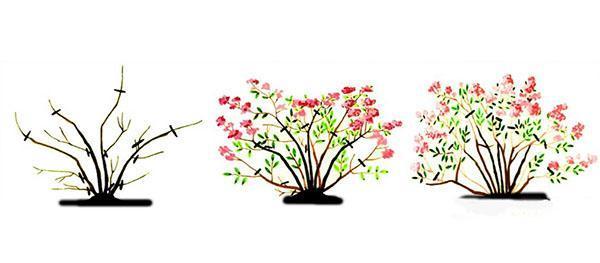Spirea care and autumn shrub pruning
 Japanese spirea is a shrub from the subspecies of summer-flowering varieties. It lends itself well to shaping and quickly recovers after pruning, so it is often used to compose landscape compositions. The shrub is well suited for alpine slides and open flower beds in the foreground. Japanese spirea blooms with beautiful pink flowers that turn purple at the end of flowering. The plant decorates well border flower beds.
Japanese spirea is a shrub from the subspecies of summer-flowering varieties. It lends itself well to shaping and quickly recovers after pruning, so it is often used to compose landscape compositions. The shrub is well suited for alpine slides and open flower beds in the foreground. Japanese spirea blooms with beautiful pink flowers that turn purple at the end of flowering. The plant decorates well border flower beds.
Autumn pruning spirea
Japanese spirea responds favorably to the formation, so it is cut off twice a year: in spring and autumn. Consider autumn pruning.
In order to get the maximum number of peduncles for the next year, autumn pruning must be carried out one month after flowering. In warm climates, it is carried out in early September, and in regions with cold climates, in mid-October.
The later you begin to form a spirea bush, the more strength the plant will accumulate for the next flowering. The shrub forms capsules with seeds that are well pollinated, so in September you can collect them for growing a new variety of spirea.
During pruning, you need to remove all dried flower stalks. The stems are cut to form a smooth, beautiful shrub. During autumn pruning, the shrub can be shaped to any shape. Most often, a ball is formed from the spirea, cutting off the shrub in a descending line downward.
Spirea care after autumn pruning
After the autumn pruning, you need:
- feed the shrub with potash and phosphorus fertilizers;
- disinfect the soil with a hot solution of potassium permanganate;
- mulch the shrub before frost.
For feeding, you can use the drug "Phosphine" or nitroammofosku. Top dressing will provide the spirea with additional nutrients that will help the shrub to form a large number of flower buds.
Disinfection of the soil with a hot solution of potassium permanganate and mulching will guarantee that the shrub will survive severe frosts. You can use lawn cuttings or shoots that were removed after pruning in the fall as mulch. Rotting, the mulch will become an additional fertilizer for the spirea, and in order for the shrub to form a large number of new shoots, the mulch is sprinkled with powder nitrogen fertilizer. After the snow melts, the fertilizer will be absorbed into the soil.